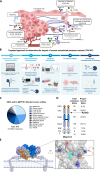Targeted approach to determine the impact of cancer-associated protease variants
- PMID: 39937919
- PMCID: PMC11818018
- DOI: 10.1126/sciadv.adp5958
Targeted approach to determine the impact of cancer-associated protease variants
Abstract
Several steps of cancer progression, from tumor onset to metastasis, critically involve proteolytic activity. To elucidate the role of proteases in cancer, it is particularly important to consider single-nucleotide variants (SNVs) that affect the active site of proteases, thereby influencing cleavage specificity, substrate processing, and thus cancer cell behavior. To facilitate systematic studies, we here present a targeted approach to determine the impact of cancer-associated protease variants (TACAP). Starting with the semiautomated identification of potential specificity-modulating SNVs, our workflow comprises mass spectrometry-based cleavage specificity profiling and substrate identification, localization, and inhibitor studies, followed by functional analyses investigating cancer cell properties. To demonstrate the feasibility of TACAP, we analyzed the meprin β R238Q variant. This amino acid exchange R238Q leads to a loss of meprin β's characteristic cleavage preference for acidic amino acids at P1' position, accompanied with changes in substrate pool and inhibitor affinity compared to meprin β wild type.
Figures







References
-
- Eatemadi A., Aiyelabegan H. T., Negahdari B., Mazlomi M. A., Daraee H., Daraee N., Eatemadi R., Sadroddiny E., Role of protease and protease inhibitors in cancer pathogenesis and treatment. Biomed. Pharmacother. 86, 221–231 (2017). - PubMed
-
- Jackson H. W., Defamie V., Waterhouse P., Khokha R., TIMPs: Versatile extracellular regulators in cancer. Nat. Rev. Cancer 17, 38–53 (2017). - PubMed
MeSH terms
Substances
LinkOut - more resources
Full Text Sources
Other Literature Sources
Medical

